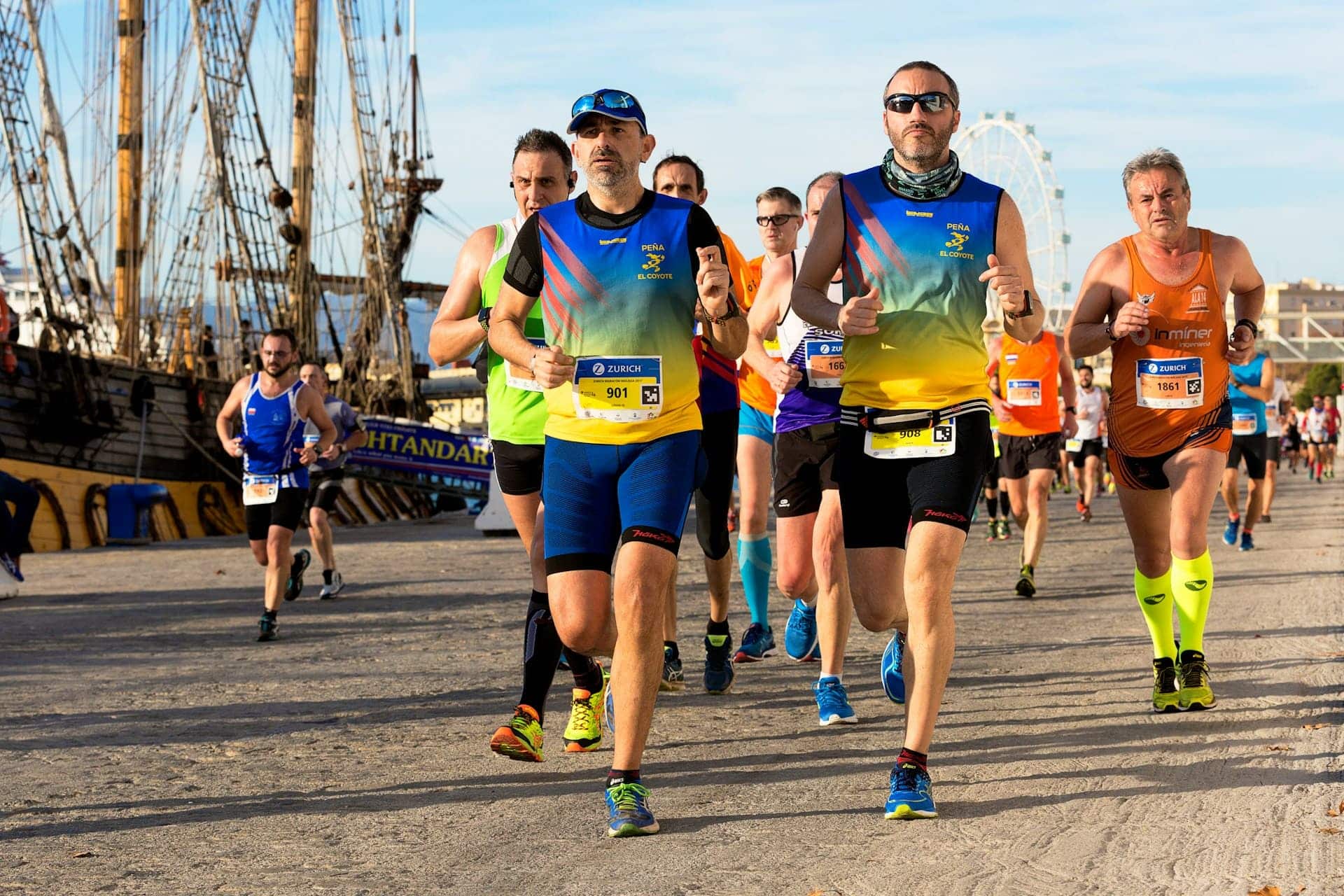Marathon Running Safety: How to Train Safely

After deciding to take up long-distance running, everyone asks: where to start and what are the best running safety tips? Basically, a healthy person without special training can overcome such a distance, albeit at a low speed, if he has iron willpower. Such cases are known, but these heroes could not walk for a couple of weeks, and some received irreversible damage to the joints.
Everyone comes to running with different goals. It is important that amateur sport is not harmful to health. With the right approach, a person will run a marathon so that he or she can run it many times again. When an unprepared or poorly prepared person runs a marathon, he gives up all his strength and health and gets injured.
Importance of Proper Training for Marathon Running
How to train for a marathon safely? The right approach is to work towards your goal gradually and train regularly. If you have no running experience at all, you can prepare for a 10km race in a couple of months, for a half-marathon – within six months, for a marathon – within a year. It is important to follow a training plan, which is better to make under the guidance of a specialist, which will take into account the initial level of physical development, chronic diseases, body mass index, age and the goal that the athlete wants to achieve.
With adequate training, runners can avoid injury, burnout, and poor performance. A well-structured marathon training plan helps to build a strong foundation, improve running efficiency, and prevent overuse injuries. It also allows runners to gradually increase their mileage and pace, leading to a more enjoyable and successful race experience.
Furthermore, road running safety tips can help runners develop mental toughness and resilience, which are essential for overcoming the challenges of marathon running. By setting realistic goals and consistent training schedule, runners can build confidence and motivation to achieve their best possible performance.
Pre-Training Health and Fitness Assessment
Before starting to prepare for marathons, it is necessary to have a health and physical fitness assessment. A thorough examination should consider your medical history, including all current and previous health issues related to injuries, diseases, and surgeries either sustained or performed. A physical exam will assess general health for risk factors that may be present.
Finally, an array of exercise-based assessments that will be carried out, including cardiovascular endurance, muscular strength, and flexibility for running safety and evaluation of readiness to run. Engaging in sports physicals may assist in determining the risks of injuries, defining reasonable expectations, personalizing the training strategies, and checking achievements.
Choosing the Right Marathon Training Plan
A good marathon training plan should align with your current fitness level, running experience, and available time for training. Beginners should look for plans that build gradually, starting with manageable distances to avoid injury. Experienced runners may seek more advanced programs with higher mileage and structured speed work to improve performance.
It’s also important to consider your personal goals and listen to health tips from doctors. Whether you want to finish the race or achieve a specific time, the plan should reflect your ambitions. For someone looking to complete their first marathon, a plan focusing on endurance building, with long runs spread out over several months, is ideal. In contrast, if you’re aiming for a personal record, you’ll need a more intense program that includes interval training, cross-training and tempo runs to increase speed and strength.
Another crucial factor is flexibility. Life can sometimes interrupt training, so it’s helpful to choose a marathon training plan that allows for adjustments without compromising overall progress. Plans that incorporate rest and recovery are also important, as they help prevent burnout and overtraining. Finally, be sure to choose a plan that matches your schedule and life commitments, ensuring you can consistently follow through.
Injury Prevention and Body Conditioning
To prevent injury, it is important to build muscles, enhance coordination and balance, and increase the body’s flexibility. Specific marathon running safety tips (strengthening exercises, flexibility exercises, and mobilization of body parts focusing on specific joints and muscles) can help. Warm-up and cool-down performances are also basic essential injury preventers.
When one is warming up, the aim is to accelerate blood circulation to the muscles. This gradually prepares the heart as well as the entire human body for more vigorous activity. Removing rest and recovery from the training cycle is just as bad. Too much working out leads to exhaustion, depletion of muscles and high chances of getting injuries. Giving the muscles time in between sessions of workouts allows the muscles to heal and grow even stronger. This is one of the most important road running safety tips.
Nutrition and Hydration Guidelines for Marathon Training
An average individual sweats out about 3-4 liters of fluids during a marathon event. As they begin to lose fluids while competing, the likelihood of developing a heart rhythm abnormality increases if those fluids are not drunk back—more so when the competition is done in a hot and humid climate.
Water intake is no less essential. The body sweats out both water and electrolytes, which, in fact, causes most people to be dehydrated despite those over 10 ways to avoid dehydration. There are more than 10 practical ways to avoid being dehydrated. Water is one of the most important fluids in the day-to-day activities of every individual; it is also very useful before, during, and after a workout. For more than an hour runs, it is in line to make use of electrolyte drinks after long hours of run to compensate for lost sodium and potassium due to perspiration.
Pre-run and post-run nutrition also play a significant role. Running safety tips say that you should focus on easily digestible carbohydrates to provide quick energy before a long run. After running, replenish glycogen stores and support muscle recovery with a mix of carbohydrates and protein. Consistently following these nutrition and hydration guidelines will optimize your training and ensure you reach race day feeling strong and prepared.
Safe Running Techniques and Form
What are 5 safety measures you can take while running? A key aspect of safe running is maintaining proper posture. Keeping your body upright, with your head looking forward and your shoulders relaxed, helps reduce strain on your back and neck. Your arms should move naturally at your sides, bent at a 90-degree angle, swinging in sync with your legs to aid in balance and momentum.
The way your feet strike the ground is also important. A midfoot or forefoot strike is generally recommended, as it allows for better shock absorption and reduces the impact on your joints compared to heel striking. Additionally, landing with your feet under your hips, rather than overextending in front of you, ensures a more efficient stride and less risk of injury.
Another critical element is stride length and cadence. Running safety includes shorter, quicker steps that often lead to better efficiency, reducing fatigue and the chance of overstriding, which can put excess strain on the body. Breathing deeply and steadily throughout your run helps deliver enough oxygen to your muscles, improving endurance and performance.
Understanding Your Limits: Listening to Your Body
Marathon running entails, in most cases, the necessity to discipline oneself and most important of all, one must learn to listen to one’s body. Here, they will push themselves so hard that they invite injuries and complete burnout, and on the other hand, they may not push themselves enough to operate at their optimal level. The same goes with the marathon; one has to have a certain marathon training plan and not cross certain boundaries yet know when to stop pushing yourself any further.
It will be useful to pay attention to your body and take some time off when needed. Overtraining is likely to result in injuries and burnout, but it is advisable to manage stress and training volume evenly.
If you’re experiencing pain or discomfort, fatigue, decreased performance, loss of appetite, or mood changes, it’s important to consult with a healthcare professional or running coach. They can help you assess your training and make necessary adjustments. Heart-healthy lifestyle habits will help you to achieve your best performance.
Safety Gear and Equipment for Marathon Running
Additional best marathon running safety tips for runners are that they should always wear the necessary safety gear and utilize the appropriate equipment. The most vital piece is a pair of running shoes that should be appropriate for one’s foot type, running style, and training surface. Proper shoes, specifically designed for the activity, are the primary defense against unnatural body functioning.
The fabric worn is directly linked to safety; light, quick-drying clothes help keep the body heat from overheating or burning. Serious, pleasant running in the countryside is often accompanied by the necessity to put on reflective gear, which increases a person’s safety. A running belt or hydration pack makes it comfier to run with water, snacks, and other necessary accessories such as a phone and medical aid. Sunglasses and hats are also great for blocking direct or excessive amounts of sun exposure. Weather conditions such as extreme cold may require appropriate gloves or jackets and windbreakers. These running safety tips hit the core and are fundamental.
Running in Different Weather Conditions: Safety Tips
Marathon training takes place across various weather conditions, and preparing for each scenario is essential for staying safe and performing well. In hot weather, wearing lightweight, moisture-wicking clothing and using sunscreen is vital to prevent overheating and sunburn.
In cold weather, layering your clothing ensures warmth while allowing you to remove layers as you warm up. Be sure to cover exposed skin to avoid frostbite and wear moisture-wicking base layers to keep sweat from freezing against your body. In wet or rainy conditions, a marathon training plan includes using water-resistant gear, especially shoes and socks, which can help prevent discomfort and blisters. Running in the rain also requires caution due to slick surfaces, so shortening your stride and wearing shoes with good traction can help prevent slips.
Dealing with Injuries: When to Rest or Seek Medical Help
Marathon training is associated with the risk of sustaining injuries, which is inevitable but unfortunate. Therefore, it is wise to have road-running safety tips. Any minor discomforts, including muscle soreness with a reasonable increase in mileage, are acceptable.
For most minor injuries, you should rest and wait because recovery involves healing. Ice, compression, and elevation can help relieve pain and reduce inflammation in the beginning stages of acute injury. However, pain that lingers on for several days gets worse or comes with other symptoms and sensations, such as swelling or bruising, must be assessed by medical professionals.
Consulting with a sports physician or physical therapist can help discuss a marathon training plan, diagnose the problem, and develop a treatment plan, which may include rehabilitation exercises or adjustments to your training routine.
Mental Preparation and Stress Management for Marathon Training
Running long distances requires mental endurance, and learning to manage stress and stay focused can make a significant difference on race day. Visualization techniques can help by allowing you to mentally rehearse the marathon experience, picturing yourself successfully navigating the course and finishing strong. Setting a realistic marathon training plan throughout your training helps build confidence, allowing you to celebrate small victories along the way. Mindfulness and meditation can reduce stress, helping you stay calm and centered during intense training periods.
Breaking the marathon into smaller, manageable segments—whether in training or on race day—helps reduce feelings of overwhelm. Developing positive self-talk is another effective strategy; reminding yourself of your strengths and progress can help maintain motivation, even on tough days.
Post-Race Recovery and Injury Prevention
The immediate hours after the race are critical for starting the recovery process. Rehydrating and replenishing lost nutrients with a combination of fluids, electrolytes, carbohydrates, and proteins is key to speeding up muscle repair. Gentle stretching or light movement helps to reduce muscle stiffness and prevent tightness from setting in.
Within marathon running safety tips, it has been warned that you should rest for a few days. Taking a break from physical exercise allows your body to recuperate properly, allowing your muscles, joints, and tendons to recover from the impact of running 26.2 miles. You might also want to try massage, foam rolling, or light swimming during recovery time, but bear in mind that you shouldn’t do any heavy physical activities.
Nevertheless, do not rush back to your normal training, as this increases the likelihood of injury. If you have been sore or in pain for a week, getting comprehensive primary care might be a good idea.
Conclusion
Now that you’ve gained insights into marathon running safety tips — covering everything from injury prevention to mental preparation — it’s time to take the first step toward your race-day goals. Equip yourself with the right plan, gear, and mindset, and start your journey to crossing the finish line strong. Keep running!


















































